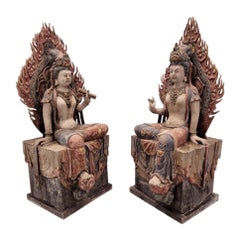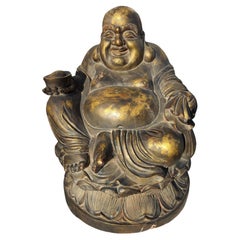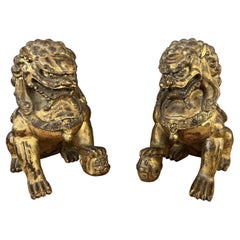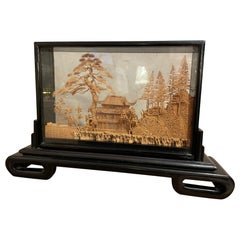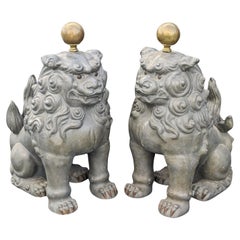Chinese Sculptures and Carvings
4
to
1
2
1
4
4
4
188
263
490
28
187
97
47
12
2
8
4
4
12
8
4
3
4
2
1
1
16
12
7
4
3
Period: 1940s
Place of Origin: Chinese
Antique Monumental Chinese Mandorla Carved Sculpted Statues - Set of 2
Located in Chicago, IL
Antique Monumental Chinese Quan-Yin Sitting Mandorla Carved Polychromed Wood Sculpted Statues - Set of 2
This set of two antique monumental Chinese Quan-Yin sitting mandorla carved ...
Category
1940s Other Vintage Chinese Sculptures and Carvings
Materials
Wood, Paint
Monumental 23" Antique Chinese Gilt Wood Budai Hotai Buddha On Lotus Seat c.1940
Located in Richmond, CA
A monumental sized (H:42") vintage Chinese gilt wood carved Budai (Hotai) Buddha lacquered and gilt in gold. This large statue is well carved, showin...
Category
1940s Qing Vintage Chinese Sculptures and Carvings
Materials
Giltwood
Vintage Pair Chinese Gilt Carved Wood Foo Dog / Guardian Lions Figurines
Located in San Francisco, CA
Offered here are a pair vintage Chinese gilt and carved wood Foo Dog/Guardian Lions figurines
Wonderful craftsmanship with the hand carving that has gone...
Category
1940s Chinese Export Vintage Chinese Sculptures and Carvings
Materials
Giltwood
Oversized Antique Chinese Cork Diorama, 1940s
Located in LEGNY, FR
Beautiful oversized antique Chinese cork asian garden diorama from the 1940s.
Stamp of the Chinese manufacturer. Blackened wood frame.
Very nice quali...
Category
1940s Vintage Chinese Sculptures and Carvings
Materials
Cork
Related Items
Vintage Pair Chinese Pewter Guardian Foo Lions Hong Kong NG AN Signed Mid 20c
Located in Richmond, CA
Pair of vintage Chinese pewter guardian lions, in fierce sitting pose, with copper accents for sharp claws, and each topped with an adjustable height brass ball attached by a threade...
Category
Mid-20th Century Chinese Export Chinese Sculptures and Carvings
Materials
Brass, Pewter
Set of 3 Antique Chinese Terracotta Plaques
Located in Wormelow, Herefordshire
These 3 antique Chinese terracotta statue plaques give a glimpse into the world of 19th century ancient China. Made in terracotta, each plaqu...
Category
Late 19th Century Antique Chinese Sculptures and Carvings
Materials
Clay, Terracotta
Pair of Chinese Black Marble Contemporary Facing Foo Dogs Guardian Lions
Located in Yonkers, NY
A pair of contemporary Chinese black marble left and right facing foo dogs guardian lions on rectangular bases. Created in China during the 21st century, this pair of black marble gu...
Category
21st Century and Contemporary Chinese Sculptures and Carvings
Materials
Marble
Japanese Old Wood Sculpture Chimpanzee 1940s-1960s / Wood Carving Mingei
Located in Sammu-shi, Chiba
This is an old Japanese wood carving of a chimpanzee.
It is from the mid-Showa period (1940s-1960s).
It is made of camphorwood.
It is a dynamic work boldly carved from a large tree....
Category
1940s Showa Vintage Chinese Sculptures and Carvings
Materials
Wood
H 23.63 in W 13.39 in D 17.72 in
Two Chinese Wood Lion Foo Dogs Incense Holder
Located in North Hollywood, CA
Two Chinese wood Foo Dogs Incense holder burners.
Featuring a pair of highly detailed lion foo dogs, one male and one female which were thought to protect the home from harmful spiritual influences and harmful people that might be a threat.
The Foo Dogs...
Category
Late 20th Century Chinese Export Chinese Sculptures and Carvings
Materials
Wood
Pair of Petite Chinese Fu Dog Guardians
Located in Chicago, IL
With curly manes and playful expressions, these petite stone fu dogs are adorable companions and benevolent guardians of the home. Also known as shizi, the pair represents yin and ya...
Category
21st Century and Contemporary Chinese Sculptures and Carvings
Materials
Limestone
Antique Chinese Carved Soapstone Spill Vase
Located in Forney, TX
An exceptionally hand-carved antique Chinese soapstone spill vase - spill holder (see below), profusely decorated and intricately detailed naturalistic sc...
Category
20th Century Chinese Sculptures and Carvings
Materials
Soapstone
Chinese Green Glazed Foo Lions, Near Pair, Late 19th Century, China
Located in Austin, TX
A charming near pair of Chinese green glazed foo lion joss stick holders, late 19th century, China.
The delightful foo lions, also referred to as foo dogs, crafted as joss (incens...
Category
Late 19th Century Qing Antique Chinese Sculptures and Carvings
Materials
Stoneware
A pair of 19th Century carved Foo temple dogs or Chinese guardian Lions
Located in London, GB
Chinese guardian lions, or imperial guardian lions, are a traditional Chinese architectural ornament. Typically made of stone, they are also known as stone lions or shishi (石獅; shíshī). They are known in colloquial English as lion dogs or foo dogs / fu dogs. The concept, which originated and became popular in Chinese Buddhism, features a pair of highly stylized lions—often one male with a ball and one female with a cub—which were thought to protect the building from harmful spiritual influences and harmful people that might be a threat. Used in imperial Chinese palaces and tombs, the lions subsequently spread to other parts of Asia including Japan (see komainu), Korea, Philippines, Tibet, Thailand, Myanmar, Vietnam, Sri Lanka, Nepal, Cambodia, Laos, and Malaysia.
There has been extensive interaction between Chinese mythology and Confucianism, Taoism, and Buddhism. Elements of pre-Han dynasty mythology such as those in Classic of Mountains and Seas were adapted into these belief systems as they developed (in the case of Taoism), or were assimilated into Chinese culture (in the case of Buddhism). Elements from the teachings and beliefs of these systems became incorporated into Chinese mythology. For example, the Taoist belief of a spiritual Paradise became incorporated into mythology as the place where immortals and deities used to dwell. Sometimes mythological and religious ideas have become widespread across China's many regions and diverse ethnic societies. In other cases, beliefs are more limited to certain social groups, for example, the veneration of white stones by the Qiang. One mythological theme that has a long history and many variations involves a shamanic world view, for example in the cases of Mongolian shamanism among the Mongols, Hmong shamanism among the Miao people, and the shamanic beliefs of the Qing dynasty from 1643 to 1912, derived from the Manchus. Politically, mythology was often used to legitimize the dynasties of China, with the founding house of a dynasty claiming a divine descent.
Mythology and philosophy.
Further information: Chinese philosophy
True mythology is distinguished from philosophical treatises and theories. Elaborations on the Wu Xing are not really part of mythology, although belief in five elements could appear. The Hundred Schools of Thought is a phrase suggesting the diversity of philosophical thought that developed during the Warring States of China. Then, and subsequently, philosophical movements had a complicated relationship with mythology. However, as far as they influence or are influenced by mythology, divides the philosophical camps into two rough halves, a Liberal group and a Conservative group. The liberal group being associated with the idea of individuality and change, for example as seen in the mythology of divination in China, such as the mythology of the dragon horse that delivered the eight bagua diagrams to Fu Xi, and methods of individual empowerment as seen in the Yi Jing (Book of Changes). The Liberal tendency is towards individual freedom, Daoism, and Nature. The relationship of the Conservative philosophies to mythology is seen in the legendary Nine Tripod Cauldrons, mythology about the emperors and central bureaucratic governance, Confucianism, written histories, ceremonial observances, subordination of the individual to the social groups of family and state, and a fixation on stability and enduring institutions. The distinction between the Liberal and Conservative is very general, but important in Chinese thought. Contradictions can be found in the details, however these are often traditional, such as the embrace by Confucius of the philosophical aspects of the Yi Jing, and the back-and-forth about the Mandate of Heaven wherein one dynasty ends and another begins based according to accounts (some of heavily mythological) where the Way of Heaven results in change, but then a new ethical stable dynasty becomes established. Examples of this include the stories of Yi Yin, Tang of Shang and Jie of Xia or the similar fantastic stories around Duke of Zhou and King Zhou of Shang.
Mythology exists in relationship with other aspects of society and culture, such as ritual. Various rituals are explained by mythology. For example, the ritual burning of mortuary banknotes (Hell Money), lighting fireworks, and so on.
A good example of the relationship of Chinese mythology and ritual is the Yubu, also known as the Steps or Paces of Yu. During the course of his activities in controlling the Great Flood, Yu was supposed to have so fatigued himself that he lost all the hair from his legs and developed a serious limp. Daoist practitioners sometimes incorporate a curiously choreographed pedal locomotion into various rituals. Mythology and practice, one explains the other: in these rituals, the sacred time of Yu merges with the sacral practice of the present.
Various ideas about the nature of the earth, the universe, and their relationship to each other have historically existed as either a background or a focus of mythologies. One typical view is of a square earth separated from a round sky by sky pillars (mountains, trees, or undefined). Above the sky is the realm of Heaven, often viewed of as a vast area, with many inhabitants. Often the heavenly inhabitants are thought to be of an "as above so below" nature, their lives and social arrangements being parallel to those on earth, with a hierarchical government run by a supreme emperor, many palaces and lesser dwellings, a vast bureaucracy of many functions, clerks, guards, and servants. Below was a vast under ground land, also known as Diyu, Yellow Springs, Hell, and other terms. As time progressed, the idea of an underground land in which the souls of the departed were punished for their misdeeds during life became explicit, related to developments in Daoism and Buddhism. The underground world also came to be conceived of as inhabited by a vast bureaucracy, with kings, judges, torturers, conductors of souls, minor bureaucrats, recording secretaries, similar to the structure of society in the Middle Kingdom (earthly China).
Chinese temple Dogs...
Category
1860s Chinese Export Antique Chinese Sculptures and Carvings
Materials
Hardwood
H 11.42 in W 20.48 in D 7.49 in
Japanese Antique Wood Carving Raccoon Dog 1900s-1940s / Object Mingei Wabi Sabi
Located in Sammu-shi, Chiba
This is a very old raccoon dog wood carving made in Japan.
This wood carving was made in the early Showa period (1900s to 1940s).
It is carved from a ...
Category
Mid-20th Century Showa Chinese Sculptures and Carvings
Materials
Cedar
H 13.98 in W 7.88 in D 7.88 in
Antique Chinese Cinnabar Box
Located in Miami, FL
A fine antique Chinese red cinnabar lacquer lidded round box carved with a scene with a young boy and a seated elderly bearded sage within a rocky landscape with trees. The "dragon's...
Category
19th Century Qing Antique Chinese Sculptures and Carvings
Materials
Lacquer
Antique Gilt Hand Carved Chinese Fragment
Located in Tampa, FL
A fabulous 18th century Chinese hand carved fragment with birds and flowers. Very deep relief gold gilt and the border is a very dark green.
Category
1890s Antique Chinese Sculptures and Carvings
Materials
Wood
Previously Available Items
Chinese San You Miniature Architectural Diorama Carved Cork Scene
Located in North Hollywood, CA
Vintage 1940s Chinese San You Diorama hand carved cork miniature architectural scene in glass case lacquered wood box.
San you are renowned for its carved...
Category
1940s Folk Art Vintage Chinese Sculptures and Carvings
Materials
Cork
Chinese Republic Period Malachite Carving of a Beauty, Meiren Early 20th Century
Located in Austin, TX
A small and wonderful Chinese carved malachite figure of a beauty, known as a meiren, Republic period, mid-20th century.
The small meiren figure ca...
Category
1940s Qing Vintage Chinese Sculptures and Carvings
Materials
Malachite
H 3.75 in W 2 in D 0.75 in
Buddha in Carved Wood Thailand, Middle of the 20th Century
Located in Saint-Ouen, FR
Wooden Buddha carved Thailand, mid-20th century, slot in the wood above the hand and under the elbow. Green and white mirror inlay.
Measures: H 70cm, W 57cm, W 37cm.
Category
1940s Chinese Export Vintage Chinese Sculptures and Carvings
Materials
Wood
Chinese Jadeite and Gold Necklace, circa 1940s
Located in New York, NY
A beautiful double strand graduated Chinese green jadeite and 14-karat gold necklace, circa 1940s China. Necklace clasp is a carved green jadeite floweret and 14-karat yellow gold. T...
Category
1940s Vintage Chinese Sculptures and Carvings
Materials
Jade, Gold
Oriental Asian Rosewood Wall Sculptural Antique Panel Screen
By George Nakashima
Located in Chula Vista, CA
For your consideration, an oriental Asian rosewood wall sculptural antique panel screen.
Made in Asia, circa 1940s.
No markings present...
Category
1940s Anglo-Japanese Vintage Chinese Sculptures and Carvings
Materials
Rosewood
Pair of Vintage Brass Foo Dogs
Located in Hopewell, NJ
A pair of vintage brass foo dogs with very striking forms.
Category
1940s Vintage Chinese Sculptures and Carvings
Materials
Brass
Polychrome Cloisonne Pheasant on Ebonized Wood Mount
Located in Chicago, IL
A wonderful and large cloisonne pheasant in beautiful shades of blue, yellow, red and green inlaid enamel, surmounted on a carved and ebonized wood base.
Category
1940s Vintage Chinese Sculptures and Carvings
Materials
Brass, Enamel
Read More
12 Calming Spaces Inspired by Japanese Design
From cherry-blossom-adorned walls paired with glamorous lighting to wood-paneled ceilings above checkerboard-patterned chairs, these 12 spaces seamlessly blend Eastern and Western aesthetics.
Rodrigo Rivero Lake’s Mexico City Showroom Is a Museum-Worthy Trove of Spanish Colonial and Asian Antiques
The dealer and curator has spent the past 50 years amassing a collection of exceptional art, furniture and architectural elements that trace the cultural influence of the Spanish empire from Europe to the Americas and beyond.
Recently Viewed
View AllMore Ways To Browse
Chinese Bell
Dragon Stone
Antique Chinese Furniture New York
Chinese Antique Furniture New York
Scale Chinese Wood
Wood Shrine
Japanese Cast Lantern
Small Japanese Carving
Wood Basin
Japanese Lantern Outdoor
Tall Pair Japanese
Ancient Wood Carvings
Green Stone Carving
Antique Japanese Buddhist
Temple Door
Box Lantern
Asian Arch
Large Buddha Hand
